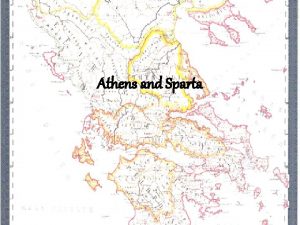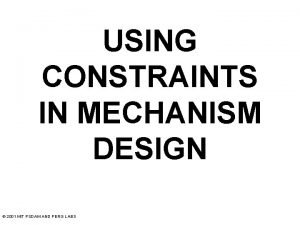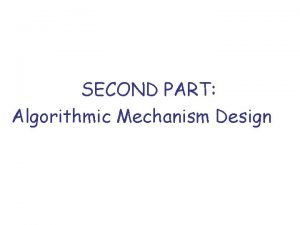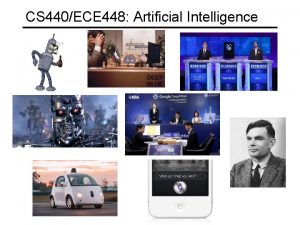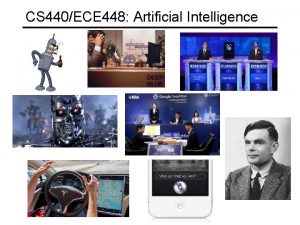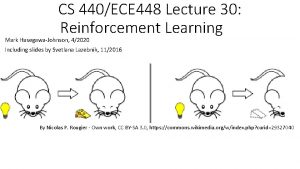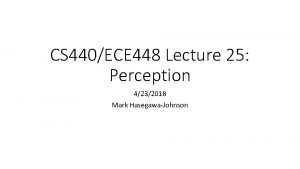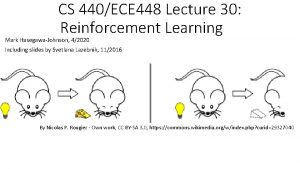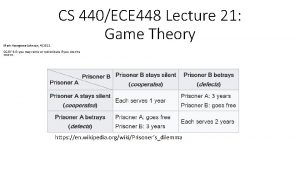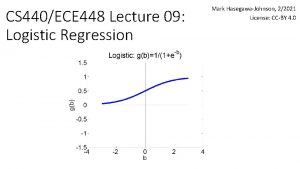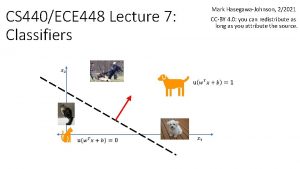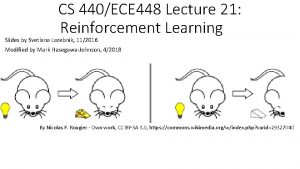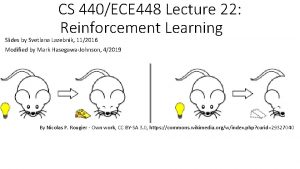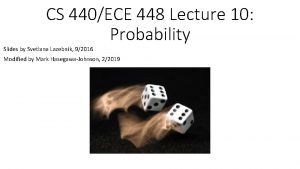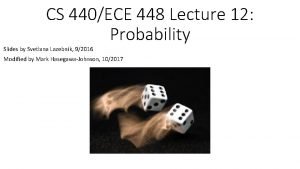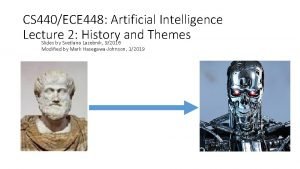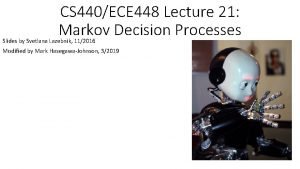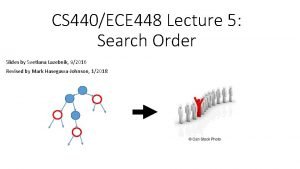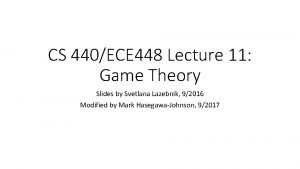CS 440ECE 448 Lecture 36 Mechanism Design Mark

























- Slides: 25

CS 440/ECE 448 Lecture 36: Mechanism Design Mark Hasegawa-Johnson, 4/2020 Including slides by Svetlana Lazebnik CC-BY 4. 0: You may remix or redistribute if you cite the source. Thomas Rowlandson & Augustus Charles Pugin, "An Auction" (1808), in The Microcosm of London, Public Domain, https: //commons. wikimedia. org/w/index. php? curid=15798707

Outline of today’s lecture • How rational are human beings? • Nash equilibria and rational decisions • The “Ultimatum Game” • Iterated games • Fixed versus random number of iterations • Iterated Prisoner’s Dilemma and the Evolution of Cooperation • Auctions • English auction, sealed-bid second-price auction • Tragedy of the Commons • The VCG (Vickrey-Clarke-Groves) mechanism

How Rational are Human Beings?

Nash equilibria and rational decisions • “Nash equilibria” are so-named because John Nash proved that every game has at least one equilibrium. • The basic idea of a Nash equilibrium: it will necessarily be the outcome of the game, if all of its assumptions are met: • Both players have the computational resources necessary to compute a rational course of action. • Player have no other actions available to them, other than the actions listed in the payoff matrix. • The payoff matrix is accurate (all costs and benefits that are valued by the player are included in the matrix).

Bounded rationality • Herbert Simon’s theory of “Bounded Rationality” says that rationality is always limited (for either humans or AI, though he didn’t put it that way) by the tractability of the problem, and by the amount of time available to solve it. • The optimum solution is often “satisficing: ” accepting the firstdiscovered solution whose utility exceeds a threshold, where threshold may decrease as one spends more time trying to solve the problem. “Paternal Love, ” Nanette Rosenzweig (1803), Public Domain, https: //commons. wikimedia. org/w/index. php? curid=295192 80

Other actions • Collusion • Russell & Norvig describe the 1999 German wireless spectrum auction: price signals were used by the bidders to communicate information to one another, completely within the auction rules set by the government. • Seeking information • In commercial auctions, bidders spend a great deal of time before the auction trying to model the purchasing power of the other bidders, in order to compete more effectively. • Think “outside the box” • “The skillful leader subdues the enemy's troops without any fighting; he captures their cities without laying siege to them; he overthrows their kingdom without lengthy operations in the field… This is the method of attacking by stratagem. ” – Sun Tzu Ninedots-2. png by Steve Gustafson, CC BY-SA 3. 0, https: //commons. wikimedia. org/w/index. php? curid=7385041

Accurate Payoff Matrix In ”The Ultimatum Game, ” Alice and Bob are given an amount of money to divide. • Alice decides how much of the money she will take ($A). She tells this amount to the experimenter, and to Bob. • Bob then decides how much of what’s left over he will accept ($B). If A+B is less than the total amount, the experimenters give them each the amount of money they chose. If not, Alice and Bob get nothing. Since the game is sequential, the Nash equilibrium is easy to compute: • Alice takes all but one penny. • Bob is then left with the choice of taking either one penny, or nothing. If he is rational, he should accept the penny. Humans don’t do that. If Alice claims more than about 70% of the total, Bob (if he is human) will typically reject the ultimatum, with the result that both players get nothing. Why? http: //en. wikipedia. org/wiki/Ultimatum_game Punch Magazine (1853). Public Domain, https: //en. wikipedia. org/w/index. php? curid=38979560

Iterated Games

Iterated games: The chain store paradox Monopolist (M) will open branches in 20 different towns. In each town, M offers to buy out the local competitor (C) for $1 M. By eliminating competition, M will earn $5 M in expected revenue. 1. C decides whether to accept the buyout or stay in business. 2. M decides whether to aggressively lower prices (resulting in 0 net income for either M or C) or charge fair prices (resulting in $2 M net income for both M and C). Competitor In Out The paradox: M should use aggressive pricing to drive one of the early competitors out of business. But aggressive pricing is not rational, according to the rules described above. Let’s explore this… https: //en. wikipedia. org/wiki/Chainstore_paradox Monopolist Aggressive Pricing Fair Pricing

Case #1: Fixed number of iterations Suppose that there are only 20 competitors; after the 20 th, M will never have to face any more competition. • If the 20 th competitor stays in, M needs to decide whether to price aggressively or fairly. Pricing aggressively would hurt his profits, with no benefit whatsoever. So the rational decision is to price fairly. • Therefore, the rational decision of the 20 th competitor is to stay in business, regardless of how many previous competitors have been driven out of business by M. • In the 19 th town, M knows that his actions have no effect on the 20 th competitor. Therefore M should price fairly. • Therefore, the rational decision of the 19 th competitor is to stay in business, regardless of how many previous competitors have been driven out of business. • … and so on… Competitor In Out Monopolist Aggressive Pricing Fair Pricing

Case #2: Random number of iterations • Competitor In Out Monopolist Aggressive Pricing Fair Pricing

What the chain store paradox shows us • If the number of iterations is known in advance, then threats become ineffective: both players know that the monopolist will act rationally, therefore both players can predict his actions. • If the number of iterations is not known in advance, then behavior that seems irrational in the short-term might be rational in the longterm. Competitor In Out Monopolist Aggressive Pricing Fair Pricing

Iterated Prisoner’s Dilemma This video is called “The Iterated Prisoner’s Dilemma and the Evolution of Cooperation” by Jesse Agar. It’s one of those great educational videos that gives you hope for the future of humanity. Enjoy!

Mechanism Design: Auctions

Auctions • Thomas Rowlandson & Augustus Charles Pugin, "An Auction" (1808), in The Microcosm of London, Public Domain, https: //commons. wikimedia. org/w/index. php? curid=15798707

Ascending-bid auction (English auction) •

Sealed-bid auction •

Sealed-bid auction: what actually happens •

Sealed-bid second-price auction (Vickrey auction) •

Dollar auction A malevolent twist on the second-price auction: • Highest bidder gets to buy the object, and pays whatever they bid • Second-highest bidder is required to pay whatever they bid, but gets nothing at all in return • Dramatization: https: //www. youtube. com/watch? v=p. A-SNsc. NADk

Mechanism Design: Tragedy of the Commons

Mechanism design (inverse game theory) • Assuming that agents pick rational strategies, how should we design the game to achieve a socially desirable outcome? • We have multiple agents and a center that collects their choices and determines the outcome

Tragedy of the Commons •

The VCG Mechanism (Vickrey-Clarke-Groves) •

Outline of today’s lecture • The Nash equilibrium is the necessary outcome of the game if its assumptions are met: • All players have sufficient computational resources to behave rationally, they have no way to perform any action except those in the payoff matrix, and the payoff matrix lists the true value, to each player, of each outcome. • Iterated games • With fixed iterations, the behavior of every actor can be predicted • With a random number of iterations, actors might behave in a manner that seems irrational in the short-term, but is rational in the long-term • Auctions • English auction: winner pays the second-highest valuation • Sealed-bid auction: winner pays what he guessed to be the second-highest valuation • Sealed-bid second-price auction: winner pays the second-highest valuation, but his dominant strategy is to tell the auctioneer his own true valuation • Tragedy of the Commons • The VCG (Vickrey-Clarke-Groves) mechanism: each player’s dominant strategy is to tell the government their true valuation of the common resource
 01:640:244 lecture notes - lecture 15: plat, idah, farad
01:640:244 lecture notes - lecture 15: plat, idah, farad Afsc 448 scmw saspo
Afsc 448 scmw saspo Jest głównym dopływem wisły ma 448 km długości
Jest głównym dopływem wisły ma 448 km długości Cs 448
Cs 448 Info 448
Info 448 500 - 448
500 - 448 Ece 448
Ece 448 Ece 448
Ece 448 Vhdl asic
Vhdl asic Cs 448
Cs 448 Factors of 448
Factors of 448 Ece448
Ece448 Ece 448
Ece 448 Fpga software
Fpga software Reinforcement lap lengths eurocodes
Reinforcement lap lengths eurocodes Elemen urban design
Elemen urban design Elements of interior design ppt
Elements of interior design ppt Lecture hall background
Lecture hall background Game design lecture
Game design lecture Computer aided drug design lecture notes
Computer aided drug design lecture notes Cmos vlsi design lecture notes
Cmos vlsi design lecture notes Hoisting mechanism
Hoisting mechanism Ken youssefi
Ken youssefi Wiper mechanism calculations
Wiper mechanism calculations Mechanism design mit
Mechanism design mit Mechanism design
Mechanism design





